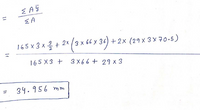A beam is subjected to equal bending moments of M, = 3500 N-m. The cross-sectional dimensions are b = 165 mm, c = 29 mm, d = 72 mm, and t = 3 mm. Determine: (a) the centroid location (measured with respect to the bottom of the cross-section), the moment of inertia about the z axis, and the controlling section modulus about the z axis. (b) the bending stress at point H. Tensile stress is positive, while compressive stress is negative. (c) the bending stress at point K. Tensile stress is positive, while compressive stress is negative. (d) the maximum bending stress produced in the cross section. Tensile stress is positive, while compressive stress is negative. M. M2 H d (typ) K Answer: (a) y= i mm Iz = i mm4 S= i mm3 (b) OH = i MPa ( c) σκ-i MPa (d) Omax i MPa
A beam is subjected to equal bending moments of M, = 3500 N-m. The cross-sectional dimensions are b = 165 mm, c = 29 mm, d = 72 mm, and t = 3 mm. Determine: (a) the centroid location (measured with respect to the bottom of the cross-section), the moment of inertia about the z axis, and the controlling section modulus about the z axis. (b) the bending stress at point H. Tensile stress is positive, while compressive stress is negative. (c) the bending stress at point K. Tensile stress is positive, while compressive stress is negative. (d) the maximum bending stress produced in the cross section. Tensile stress is positive, while compressive stress is negative. M. M2 H d (typ) K Answer: (a) y= i mm Iz = i mm4 S= i mm3 (b) OH = i MPa ( c) σκ-i MPa (d) Omax i MPa
Engineering Fundamentals: An Introduction to Engineering (MindTap Course List)
5th Edition
ISBN:9781305084766
Author:Saeed Moaveni
Publisher:Saeed Moaveni
Chapter12: Electric Current And Related Variables In Engineering
Section12.2: Electrical Circuits And Components
Problem 6BYG
Related questions
Question
100%

Transcribed Image Text:A beam is subjected to equal bending moments of M, = 3500 N-m. The cross-sectional dimensions are b = 165 mm, c = 29 mm, d = 72
mm, and t = 3 mm. Determine:
(a) the centroid location (measured with respect to the bottom of the cross-section), the moment of inertia about the z axis, and the
controlling section modulus about the z axis.
(b) the bending stress at point H. Tensile stress is positive, while compressive stress is negative.
(c) the bending stress at point K. Tensile stress is positive, while compressive stress is negative.
(d) the maximum bending stress produced in the cross section. Tensile stress is positive, while compressive stress is negative.
M2
M2
H
d
(tур)
K
Answer:
(a) y= i
mm
z= i
mm4
S= i
mm3
(b) OH = i
MPa
(c) σκ-i
MPa
(d) Omax
i
MPa
Expert Solution
This question has been solved!
Explore an expertly crafted, step-by-step solution for a thorough understanding of key concepts.
Step by step
Solved in 3 steps with 3 images

Follow-up Questions
Read through expert solutions to related follow-up questions below.
Follow-up Question
How did you get 36 in "(3 x 66 x 36)" and the 70.5 in "(29 x 3 x 70.5)"?

Transcribed Image Text:E AG
145x3x을+ 2x(3x4"y 30) +2x (29 x 3 x 70-5)
+2x (29 x 3x 구o.5)
165 X 3 +
3X66 + 29 x 3
34.956 mm
%3D
Solution
Knowledge Booster
Learn more about
Need a deep-dive on the concept behind this application? Look no further. Learn more about this topic, civil-engineering and related others by exploring similar questions and additional content below.Recommended textbooks for you

Engineering Fundamentals: An Introduction to Engi…
Civil Engineering
ISBN:
9781305084766
Author:
Saeed Moaveni
Publisher:
Cengage Learning

Steel Design (Activate Learning with these NEW ti…
Civil Engineering
ISBN:
9781337094740
Author:
Segui, William T.
Publisher:
Cengage Learning

Residential Construction Academy: House Wiring (M…
Civil Engineering
ISBN:
9781285852225
Author:
Gregory W Fletcher
Publisher:
Cengage Learning

Engineering Fundamentals: An Introduction to Engi…
Civil Engineering
ISBN:
9781305084766
Author:
Saeed Moaveni
Publisher:
Cengage Learning

Steel Design (Activate Learning with these NEW ti…
Civil Engineering
ISBN:
9781337094740
Author:
Segui, William T.
Publisher:
Cengage Learning

Residential Construction Academy: House Wiring (M…
Civil Engineering
ISBN:
9781285852225
Author:
Gregory W Fletcher
Publisher:
Cengage Learning

Materials Science And Engineering Properties
Civil Engineering
ISBN:
9781111988609
Author:
Charles Gilmore
Publisher:
Cengage Learning

Principles of Foundation Engineering (MindTap Cou…
Civil Engineering
ISBN:
9781337705028
Author:
Braja M. Das, Nagaratnam Sivakugan
Publisher:
Cengage Learning

Principles of Foundation Engineering (MindTap Cou…
Civil Engineering
ISBN:
9781305081550
Author:
Braja M. Das
Publisher:
Cengage Learning